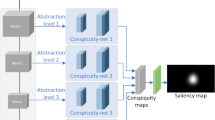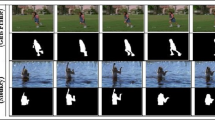Abstract
Visual saliency modeling for images and videos is treated as two independent tasks in recent computer vision literature. While image saliency modeling is a well-studied problem and progress on benchmarks like SALICON and MIT300 is slowing, video saliency models have shown rapid gains on the recent DHF1K benchmark. Here, we take a step back and ask: Can image and video saliency modeling be approached via a unified model, with mutual benefit? We identify different sources of domain shift between image and video saliency data and between different video saliency datasets as a key challenge for effective joint modelling. To address this we propose four novel domain adaptation techniques—Domain-Adaptive Priors, Domain-Adaptive Fusion, Domain-Adaptive Smoothing and Bypass-RNN—in addition to an improved formulation of learned Gaussian priors. We integrate these techniques into a simple and lightweight encoder-RNN-decoder-style network, UNISAL, and train it jointly with image and video saliency data. We evaluate our method on the video saliency datasets DHF1K, Hollywood-2 and UCF-Sports, and the image saliency datasets SALICON and MIT300. With one set of parameters, UNISAL achieves state-of-the-art performance on all video saliency datasets and is on par with the state-of-the-art for image saliency datasets, despite faster runtime and a 5 to 20-fold smaller model size compared to all competing deep methods. We provide retrospective analyses and ablation studies which confirm the importance of the domain shift modeling. The code is available at https://github.com/rdroste/unisal.
R. Droste and J. Jiao—Contributed equally to this work.
Access this chapter
Tax calculation will be finalised at checkout
Purchases are for personal use only
Similar content being viewed by others
References
Bak, C., Kocak, A., Erdem, E., Erdem, A.: Spatio-temporal saliency networks for dynamic saliency prediction. IEEE TMM 20(7), 1688–1698 (2017)
Borji, A.: Saliency prediction in the deep learning era: an empirical investigation. arXiv:1810.03716 (2018)
Borji, A., Itti, L.: State-of-the-art in visual attention modeling. IEEE TPAMI 35(1), 185–207 (2012)
Bousmalis, K., Trigeorgis, G., Silberman, N., Krishnan, D., Erhan, D.: Domain separation networks. In: NeurIPS (2016)
Bylinskii, Z., Judd, T., Oliva, A., Torralba, A., Durand, F.: What do different evaluation metrics tell us about saliency models? IEEE TPAMI 41(3), 740–757 (2019)
Chang, W.G., You, T., Seo, S., Kwak, S., Han, B.: Domain-specific batch normalization for unsupervised domain adaptation. In: CVPR (2019)
Cornia, M., Baraldi, L., Serra, G., Cucchiara, R.: Predicting human eye fixations via an LSTM-based saliency attentive model. IEEE TIP 27(10), 5142–5154 (2016)
Fang, Y., Wang, Z., Lin, W., Fang, Z.: Video saliency incorporating spatiotemporal cues and uncertainty weighting. IEEE TIP 23(9), 3910–3921 (2014)
Gal, Y., Ghahramani, Z.: A Theoretically grounded application of dropout in recurrent neural networks. In: NeurIPS (2016)
Gorji, S., Clark, J.J.: Going from image to video saliency: augmenting image salience with dynamic attentional push. In: CVPR (2018)
Guo, C., Ma, Q., Zhang, L.: Spatio-temporal saliency detection using phase spectrum of quaternion fourier transform. In: CVPR (2008)
Guo, C., Zhang, L.: A novel multiresolution spatiotemporal saliency detection model and its applications in image and video compression. IEEE TIP 19(1), 185–198 (2009)
Harel, J., Koch, C., Perona, P.: Graph-based visual saliency. In: NeurIPS (2007)
Hossein Khatoonabadi, S., Vasconcelos, N., Bajic, I.V., Shan, Y.: How many bits does it take for a stimulus to be salient? In: CVPR (2015)
Hou, X., Zhang, L.: Dynamic visual attention: searching for coding length increments. In: NeurIPS (2009)
Huang, X., Shen, C., Boix, X., Zhao, Q.: SALICON: reducing the semantic gap in saliency prediction by adapting deep neural networks. In: ICCV (2015)
Itti, L., Koch, C., Niebur, E.: A model of saliency-based visual attention for rapid scene analysis. IEEE TPAMI 20(11), 1254–1259 (1998)
Jetley, S., Murray, N., Vig, E.: End-to-end saliency mapping via probability distribution prediction. In: CVPR (2016)
Jiang, L., Xu, M., Liu, T., Qiao, M., Wang, Z.: DeepVS: a deep learning based video saliency prediction approach. In: ECCV (2018)
Jiang, M., Huang, S., Duan, J., Zhao, Q.: SALICON: saliency in context. In: CVPR (2015)
Judd, T., Durand, F., Torralba, A.: A Benchmark of computational models of saliency to predict human fixations. In: MIT-CSAIL-TR-2012, vol. 1, pp. 1–7 (2012)
Judd, T., Ehinger, K., Durand, F., Torralba, A.: Learning to predict where humans look. In: ICCV (2009)
Kruthiventi, S.S.S., Ayush, K., Babu, R.V.: DeepFix: a fully convolutional neural network for predicting human eye fixations. IEEE TIP 26(9), 4446–4456 (2015)
Kümmerer, M., Wallis, T.S.A., Bethge, M.: DeepGaze II: reading fixations from deep features trained on object recognition. arXiv:1610.01563 (2016)
Lai, Q., Wang, W., Sun, H., Shen, J.: Video saliency prediction using spatiotemporal residual attentive networks. IEEE TIP 26, 1113–1126 (2019)
Le Meur, O., Le Callet, P., Barba, D., Thoreau, D.: A coherent computational approach to model bottom-up visual attention. IEEE TPAMI 28(5), 802–817 (2006)
Leboran, V., Garcia-Diaz, A., Fdez-Vidal, X.R., Pardo, X.M.: Dynamic whitening saliency. IEEE TPAMI 39(5), 893–907 (2016)
Li, Y., Wang, N., Shi, J., Liu, J., Hou, X.: Revisiting batch normalization for practical domain adaptation. In: ICLR (2016)
Linardos, P., Mohedano, E., Nieto, J.J., McGuinness, K., Giro-i Nieto, X., O’Connor, N.E.: Simple vs complex temporal recurrences for video saliency prediction. In: BMVC (2019)
Liu, J., Shahroudy, A., Xu, D., Wang, G.: Spatio-temporal LSTM with trust gates for 3D human action recognition. In: Leibe, B., Matas, J., Sebe, N., Welling, M. (eds.) ECCV 2016. LNCS, vol. 9907, pp. 816–833. Springer, Cham (2016). https://doi.org/10.1007/978-3-319-46487-9_50
Maaten, L.V.D., Hinton, G.: Visualizing data using t-SNE. J. Mach. Learn. Res. 9(Nov), 2579–2605 (2008)
Mahadevan, V., Vasconcelos, N.: Spatiotemporal saliency in dynamic scenes. IEEE TPAMI 32(1), 171–177 (2009)
Marat, S., Phuoc, T.H., Granjon, L., Guyader, N., Pellerin, D., Guérin-Dugué, A.: Modelling spatio-temporal saliency to predict gaze direction for short videos. Int. J. Comput. Vis. 82(3), 231 (2009)
Mathe, S., Sminchisescu, C.: Actions in the eye: dynamic gaze datasets and learnt saliency models for visual recognition. IEEE TPAMI 37(7), 1408–1424 (2015)
Min, K., Corso, J.J.: TASED-net: temporally-aggregating spatial encoder-decoder network for video saliency detection. In: ICCV (2019)
Pan, J., et al.: SaLGAN: visual saliency prediction with generative adversarial networks. arXiv:1701.01081 (2017)
Pan, J., Sayrol, E., Giro-i Nieto, X., McGuinness, K., O’Connor, N.E.: Shallow and deep convolutional networks for saliency prediction. In: CVPR (2016)
Rozantsev, A., Salzmann, M., Fua, P.: Beyond sharing weights for deep domain adaptation. IEEE TPAMI 41(4), 801–814 (2019)
Rudoy, D., Goldman, D.B., Shechtman, E., Zelnik-Manor, L.: Learning video saliency from human gaze using candidate selection. In: CVPR (2013)
Sandler, M., Howard, A., Zhu, M., Zhmoginov, A., Chen, L.C.: MobileNetV2: inverted residuals and linear bottlenecks. In: CVPR (2018)
Seo, H.J., Milanfar, P.: Static and space-time visual saliency detection by self-resemblance. J. Vis. 9(12), 15–15 (2009)
Sun, Y., Fisher, R.: Object-based visual attention for computer vision. Artif. Intell. 146(1), 77–123 (2003)
Tsai, J.C., Chien, J.T.: Adversarial domain separation and adaptation. In: 2017 IEEE 27th International Workshop on Machine Learning for Signal Processing (MLSP), pp. 1–6 (2017)
Valipour, S., Siam, M., Jagersand, M., Ray, N.: Recurrent fully convolutional networks for video segmentation. In: IEEE WACV, pp. 29–36 (2017)
Vig, E., Dorr, M., Cox, D.: Large-scale optimization of hierarchical features for saliency prediction in natural images. In: CVPR (2014)
Wang, W., Shen, J.: Deep visual attention prediction. IEEE TIP 27(5), 2368–2378 (2017)
Wang, W., Shen, J., Guo, F., Cheng, M.M., Borji, A.: Revisiting video saliency: a large-scale benchmark and a new model. In: CVPR (2018)
Wang, W., Shen, J., Xie, J., Cheng, M.M., Ling, H., Borji, A.: Revisiting video saliency prediction in the deep learning era. IEEE TPAMI (2019, early access)
Xiao, T., Li, H., Ouyang, W., Wang, X.: Learning deep feature representations with domain guided dropout for person re-identification. arXiv:1604.07528 (2016)
Yang, S., Lin, G., Jiang, Q., Lin, W.: A dilated inception network for visual saliency prediction. IEEE TMM 22(8), 2163–2176 (2020)
Zheng, Q., Jiao, J., Cao, Y., Lau, R.W.: Task-driven webpage saliency. In: ECCV (2018)
Zhong, S.H., Liu, Y., Ren, F., Zhang, J., Ren, T.: Video saliency detection via dynamic consistent spatio-temporal attention modelling. In: AAAI (2013)
Acknowledgements
We acknowledge the EPSRC (Project Seebibyte, reference EP/M013774/1) and the NVIDIA Corporation for the donation of GPU.
Author information
Authors and Affiliations
Corresponding author
Editor information
Editors and Affiliations
1 Electronic supplementary material
Below is the link to the electronic supplementary material.
Rights and permissions
Copyright information
© 2020 Springer Nature Switzerland AG
About this paper
Cite this paper
Droste, R., Jiao, J., Noble, J.A. (2020). Unified Image and Video Saliency Modeling. In: Vedaldi, A., Bischof, H., Brox, T., Frahm, JM. (eds) Computer Vision – ECCV 2020. ECCV 2020. Lecture Notes in Computer Science(), vol 12350. Springer, Cham. https://doi.org/10.1007/978-3-030-58558-7_25
Download citation
DOI: https://doi.org/10.1007/978-3-030-58558-7_25
Published:
Publisher Name: Springer, Cham
Print ISBN: 978-3-030-58557-0
Online ISBN: 978-3-030-58558-7
eBook Packages: Computer ScienceComputer Science (R0)




